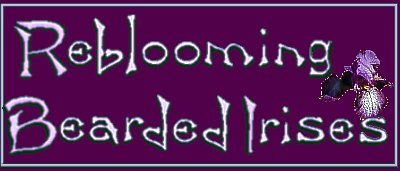About Tall Bearded Irises
Tall Bearded Iris (TB) grow bloom stalks over 27.5 inches in height.
|

|
- Cultivation information
- When: Late summer through early fall is the best time to plant the rhizomes.
Depending on your location late August through September is best.
If your garden is in the south part of the US you may be able to plant into November.
The irises are shipped as bare rhizomes and they will set roots and grow between planting and winter.
Spring planting is undesirable although it can be done in unusual
circumstances, but it can result in slow growth and lack of bloom.
- Where: Bearded Irises like sun and dry soil, they need at least half a day of full sun.
At Sans Souci the production beds are in full sun.
- Soils:
Bearded iris need balanced, well-drained soil. Raised beds help with
drainage and are a MUST for areas with high rainfall.
Iris do best in neutral to slightly alkaline soil (PH of 6.8 - 7.0). Heavy
clays need to be modified with gypsum or coarse sand to aid drainage. Till
the soil down to 10-12", add a dash of superphosphate or bone meal and mix well.
In areas with severe winters, bearded iris can be mulched lightly
(for winter protection and weed control) as long as
the mulch DOES NOT COVER the rhizome. Mulch must be removed in the spring or the rhizomes will
rot.
- Planting the rhizomes: - Do not plant the rhizomes below soil level! ,
Beared iris rhizomes are a modified stems and lie along the surface of the ground. The roots needd to be
buried but the top of the rhizome should be exposed.
- Make a 3" deep depression about 6" in diameter.
- In the center
create a small fist-sized mound of soil.
- Place the rhizome on top of the mound so that 1/3
of it will be above the soil.
- Spread the roots of the rhizome out to support the
plant, replace the soil, firmly packed around the roots to remove air pockets.
- Water liberally ONLY at this time of initial planting to settle the soil. Bearded Irises are semi-desert plants and, once established, additional watering is ONLY needed in times of severe drought.
- Bearded iris should not be planted in a low lying areas; they are a dry
land plant and need drainage.
- Spacing: Rhizomes should be spaced at 14-18 inches allowing for new growth to fill the area between
plants in about three years. In areas of intense heat plant iris a little
deeper, but no more than 1" below the soil surface. This rule also applies to
areas with light soils.
- Fertilizers - With their large blooms and greater number of buds, our
modern iris need more fertilizer than older varieties. We in mid to late April with bone
meal, superphosphate, or a fertilizer low in nitrogen such as 6-10-10. Iris do not like acid soils
and fertilizers high in nitrogen tend to cause bacterial rot and lush, but weak,
foliage growth.
In fertilizers the second and third numbers represent the amount of phosphorous and potassium in the
mixture and fertilizers for iris should have higher levels of these two nutrients. They are the key
to bloom and root production.
A second 1/2 strength dose of fertilizier can be applied in the fall following dividing and
replanting.
- Our tips for bearded iris care:
As Iris clumps become crowded the bloom will reduce, In addition bearded iris seem to do poorly when
growing on the same soil beyond 5 to 6 years. Dividing and replanting your clumps in a new location
will revive the plants.
To the frustration of fanciers, in the wild and in early cultivars, bearded
irises had a relatively short period of spring bloom. However fanciers and
hybridiziers through selective breeding have produced strains called rebloomers that can have a
return to bloom (that is rebloom) after a period of dormancy in the summer.
Reblooming is dependent upon cultivation zone and varies with region as well as
with the Cultivar. Rebloomers require more water for late summer or early fall
rebloom. Rebloomers may or may not rebloom in your
climate. Purchasing reblooming varieties that are proven rebloomers in your
region from a local nursery enhances the likely hood that they will rebloom in
your garden.
A good selection of rebloomers is now available from many Iris breeders among the bearded irises in
all the size ranges and in many colors.
|